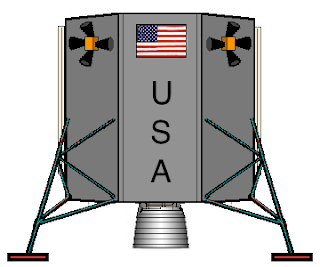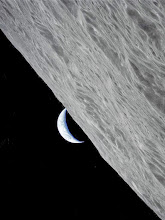 |
| Notional crewed ELV-3 on the surface of the Moon |
During NASA's Constellation program, the American space agency chose Boeing's Altair concept as the landing vehicle design to return American astronauts to the surface of the Moon. As a two staged (descent and ascent) crew landing vehicle and as a single stage cargo landing vehicle, the Altair was supposed to be housed in the large payload fairing of the Ares V super heavy lift rocket. But in 2010, the Constellation program was canceled by the Obama administration, a decision that became law in April of 2011. And this ended the development of Ares V and Altair lunar landing vehicle.
 |
| Notional Altair crew landing vehicle (Credit: NASA) |
 |
| Notional Altair cargo landing vehicle (Credit: NASA) |
 |
| 2.4 meter super lightweight cryotank (Credit: Boeing Aerospace) |
 |
| Notional ELV-3 lunar lander display retractable panel |
 |
| X-ray view of three tank configuration for ELV-3 |
 |
| View of ELV-3 radiator and side thrusters |
 |
| Top x-ray view of ELV-3 and its three tank configuration |
The problems associated with eight feedlines, differential tank pull due to unuasable propellant, increased tank heating resulting from the numerous tank penetrations, problems with pressure control during burns and long coastal phases caused by the large number of tanks are significantly reduced by reducing the cryotank numbers from eight down to just three. Utilizing just three tanks also reduces the overall mass of the tank weight.
Problems associated with the RL-10 exhaust plume just a few meters above the lunar surface during landings could be alleviated by using side thrusters positioned well above the surface. Additionally, the IVF (Integrated Vehicle Fluids) ullage gas fueled thrusters could also be automatically extended outwards away from the side panels (more than 8.4 meters in diameter) for exceptionally large payloads that extend beyond the diameter of the octagonal panels.
While the deck of the ELV-3 would be approximately two meters higher than the Altair, the ELV-3 would have the advantage of a substantial amount of empty space on each side of the linear aligned propellant tanks. Twin retractable wall panels on each side could accommodate a rectangular cargo area at least 7.2 meters high by 2.2 meters by 2.8 meters.
ELV-3 - Cargo Lander
One 2.4 meter in diameter LOX tank
Two 2.4 meter in diameter LH2 tanks
IVF thrusters utilize ullage gasses
Dry mass: 8 tonnes
Propellant mass: 31 tonnes
Maximum cargo mass to lunar surface from NRO (Near Rectilinear Orbit): 30 tonnes
Maximum cargo mass to lunar surface from LLO: 39 tonnes
 |
| Twin mobile lunar cranes stored within the ELV-3 side cargo areas with additional cargo located at the top central area |
The large dimensions of the side cargo areas would also be able to accommodate twin mobile lunar cranes with telescopic booms extending well above the the top deck. Each electric powered crane would be equipped with a cable hook for unloading large payloads and with cable clamshells for digging up and redepositing lunar regolith. With each mobile crane already weighing more than 12 tonnes, the deposition of lunar regolith (weighing approximately 1.5 tonnes per square meter) into the automatically expanded regolith bins of the other vehicle could increase each crane's counter weight by more than 18 tonnes. This would allow each mobile crane to be able to easily offload payloads on top of the ELV-3 weighing nearly 30 tonnes. If devices are deployed to the lunar surface to magnetically extract iron and other metallic dust from the top ten centimeters of lunar regolith then the deposition of this much heavy material into the regolith bins could easily increase the counter weights of the mobile cranes by more than 100 tonnes.
 |
| Panel deployment of twin mobile lunar cranes |
 |
| Notional electric powered mobile lunar crane |
ELV-3 - Crew lander
Dry mass with mass with passengers, cargo, and radiation shielding: 16 tonnes
Maximum additional cargo to and from the lunar surface if able to refuel on the lunar surface: 14 tonnes
 |
| Notional ELV-3 crew landing vehicle |
Because of its weight and limited fuel (up to 31 tonnes of LOX/LH2 propellant), two vehicles would be required for round trip sortie missions between NRO and the lunar surface. One ELV-3 would be used to transport the other ELV-3 and its crew to low lunar orbit while the crewed ELV-3 would land on the lunar surface and then return to lunar orbit after its mission where the orbiting ELV-3 would transport both vehicles back to NRO. So spacecraft such as the ULA's XEUS (up to 68 tonnes of LOX/LH2 propellant) and Lockheed Martin's MADV (80 tonnes of LOX/LH2 propellant) would be much more capable than the ELV-3 as a crew launch vehicle for sortie missions since only one vehicle is required for sortie missions originating from NRO.
However, once propellant producing depots are deployed to the lunar surface, only one ELV-3 vehicle would be required to transport crews between the Earth-Moon Lagrange points and the lunar surface and back. Additionally, the crewed versions of the ELV-3 would have a major advantage by being able to transport both astronauts plus more than 14 tonnes of additional payload to and from the lunar surface when fully fueled.
 |
| After a side panel is deployed, astronauts ride an electric powered scissor lift down towards the lunar surface |
Utilizing its side cargo areas, an unmanned ELV-3 could also be used to deploy a multitude of mobile robots to the surfaces the Moon, the moons of Mars (Deimos and Phobos), to the moons of Jupiter (Io, Ganymede, Europa, and Callisto), and even to the surfaces of some of the the largest asteroids in the asteroid belt (Ceres, Vesta, Pallas, etc.).
Links and References
Robust Lunar Exploration Using an Efficient Lunar Lander Derived from Existing Upper Stages
Tanks for a Great Idea
Game Changing Propellant Tank
2.4 meter composite cryogenic tank at Boeing Developmental Center























